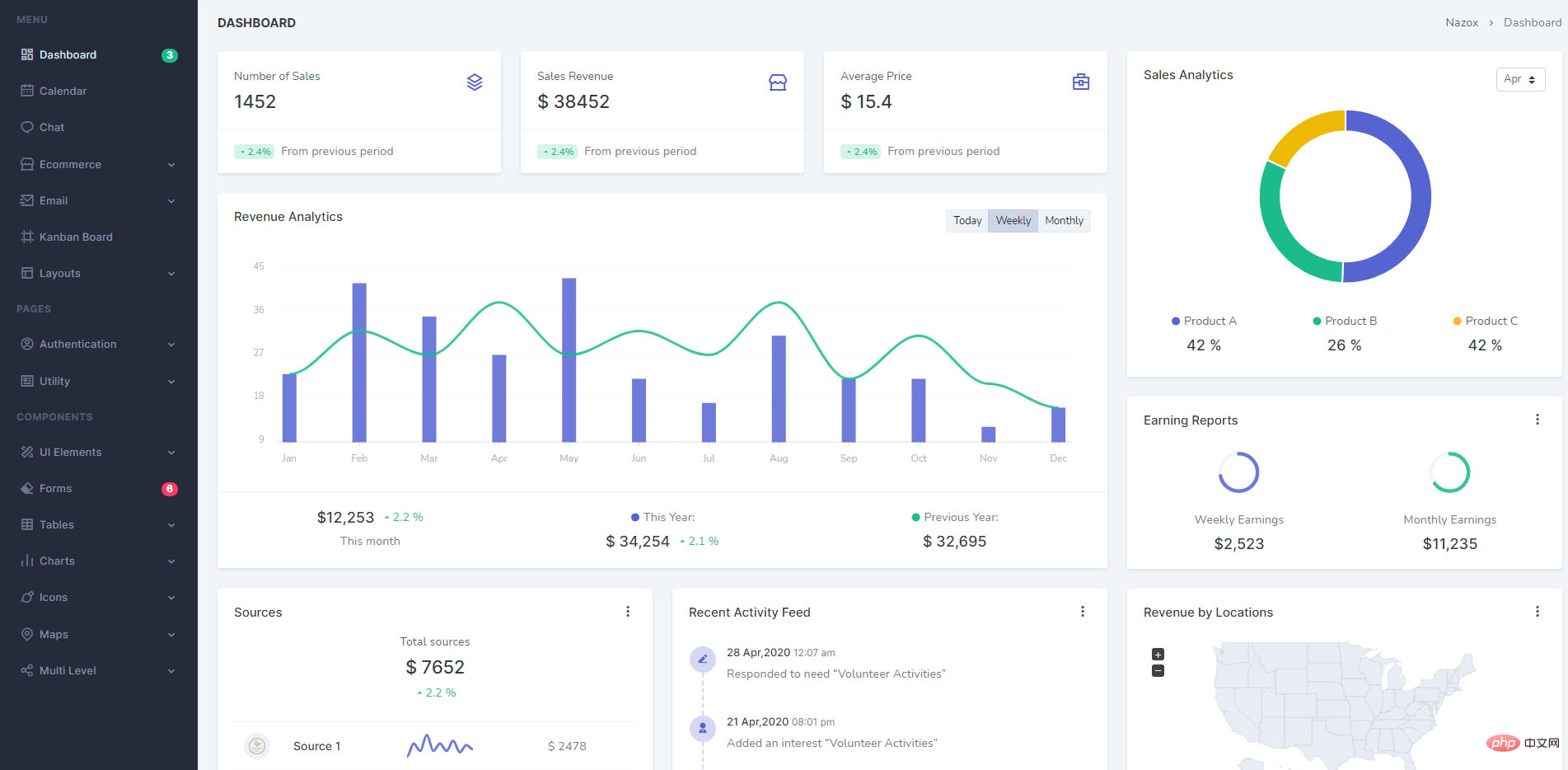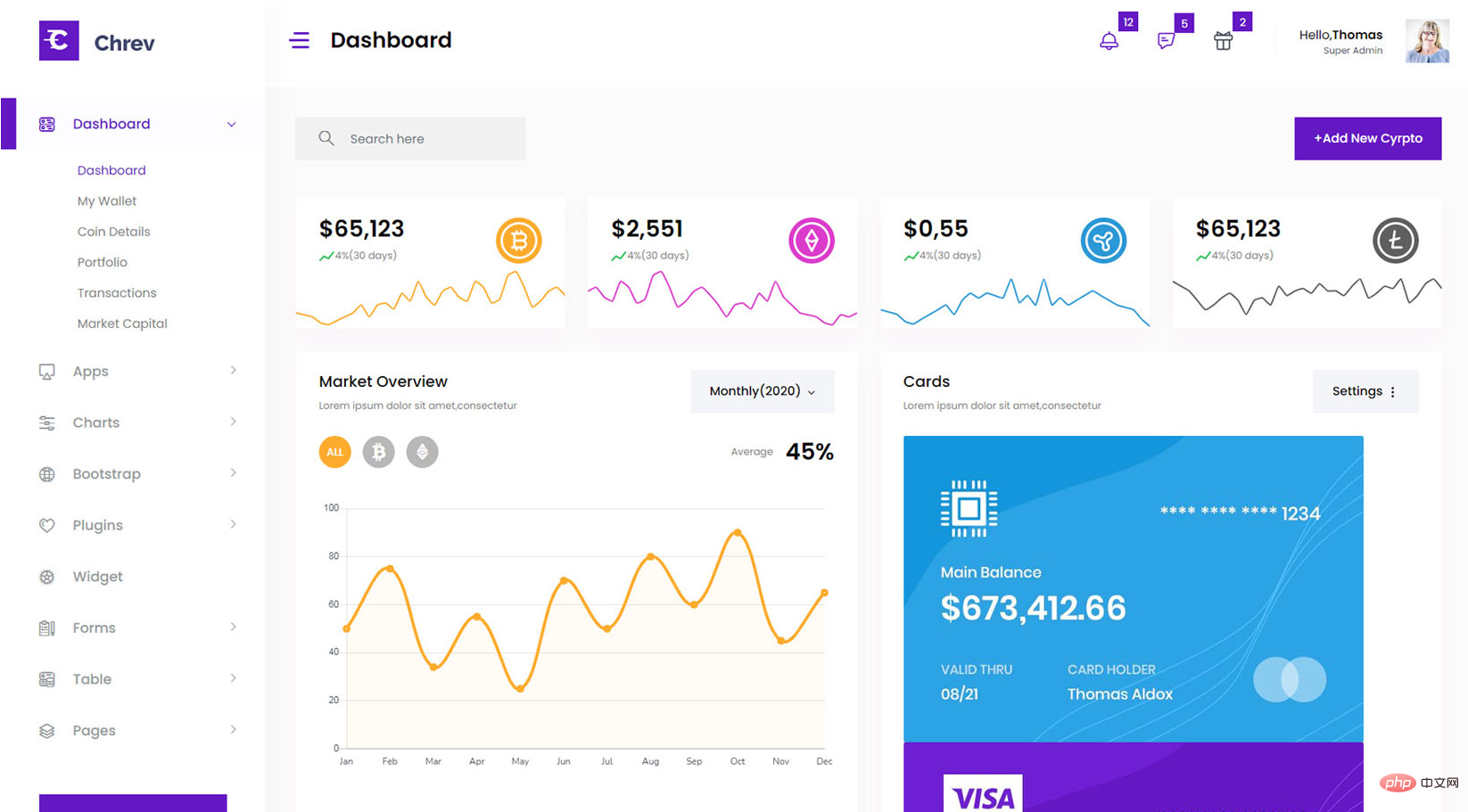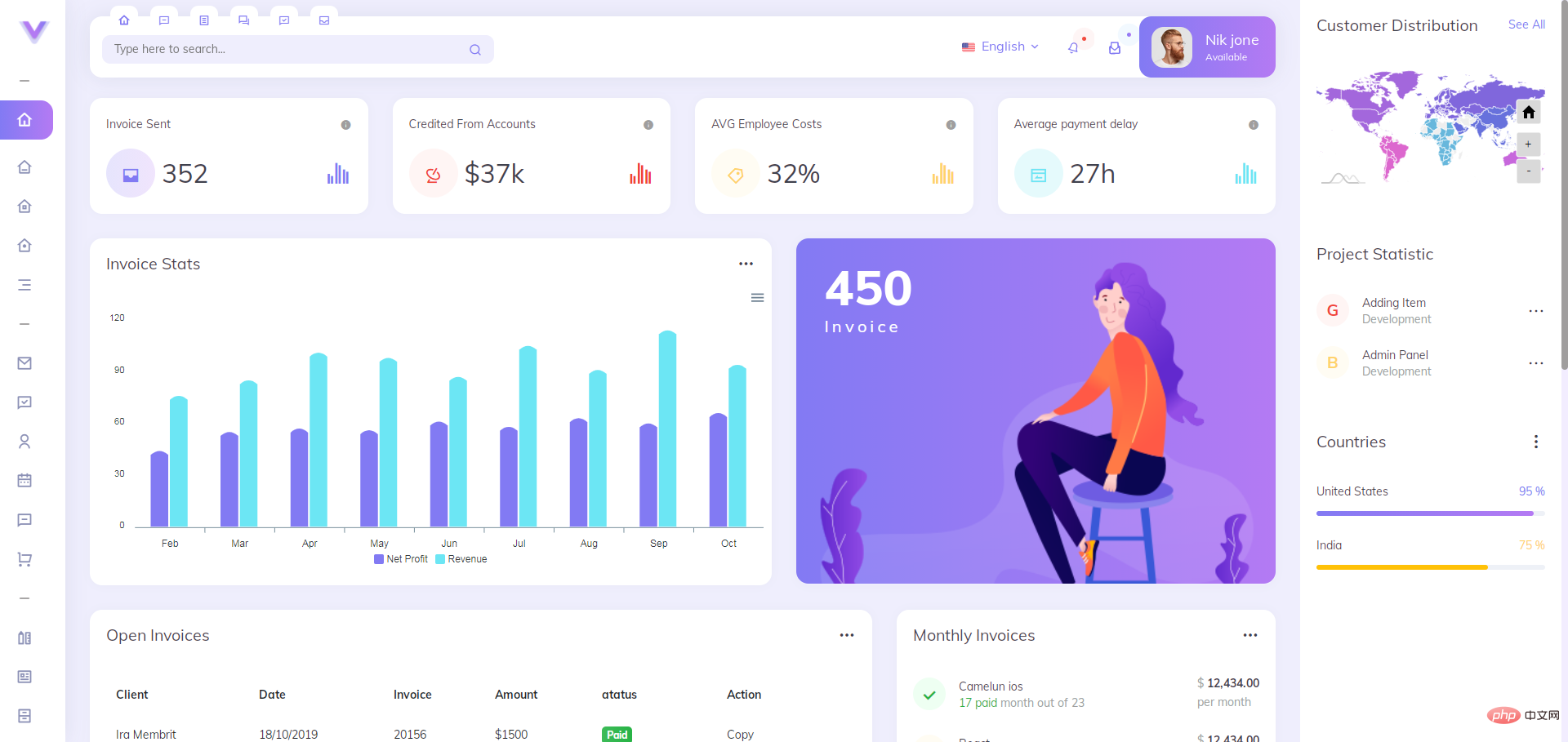 PHP Framework
PHP Framework
 Laravel
Laravel
 6 cool and practical Laravel backend management templates (free download)
6 cool and practical Laravel backend management templates (free download)
6 cool and practical Laravel backend management templates (free download)
A good website cannot just look at its appearance. The background of the website is also very important. This article will share with you 6 cool and practical Laravel backend management templates, which can be downloaded for free! If you want to get more website templates, please pay attention to the php Chinese website source code column!
1. Laravel and TailwindCSS background management template-Midone

Template introduction: Midone is a set of high-quality Laravel management Background template, TailwindCSS framework component template. Front-end scaffolding and directory structure design and production use. The template has several unique pages and components to help you quickly build an admin application. At the same time, you can focus on developing projects without worrying about front-end HTML template integration.
Effect preview and download address: https://www.php.cn/xiazai/code/6944
##2. Powerful Laravel management background UI Framework source code - Nazox

https://www.php.cn/xiazai/code/6943
##3, HTML and Laravel digital currency system Management template - Chrev
 Template introduction: Chrev is a digital currency system interface template, including two versions of HTML and Laravel source code. Cryptocurrency trading systems, digital currency management systems, etc. can be created. Of course, this set of templates can also be used to create any other website backend and web applications, because it contains commonly used web page elements and components.
Template introduction: Chrev is a digital currency system interface template, including two versions of HTML and Laravel source code. Cryptocurrency trading systems, digital currency management systems, etc. can be created. Of course, this set of templates can also be used to create any other website backend and web applications, because it contains commonly used web page elements and components.
Effect preview and download address:
https://www.php.cn/xiazai/code/6942##4. laravel8 bootstrap management background template UI Framework-Dashmix
Template introduction: Dashmix is a fully responsive commercial bootstrap management background template, including the template and UI framework implemented by Laravel8. Built in Sass and ECMAScript6 (ES6) and smart tools like webpack5, Babel7, and Gulp4, it will save you time and help you build your projects faster and more efficiently. Templates will enable you to build a variety of page layouts quickly and powerfully. This set of backend templates is a professional, flexible, modern and full-featured admin backend template that can be used to create UI for all projects: web applications, website backends, websites, custom admin panels, admin dashboards, CMS, CRM Even a blog, corporate website. 
https://www.php.cn/xiazai/code/6844
##5. Vuejs Laravel management background system template Framework
# Template introduction: A set of simple VueJS Laravel management templates, a management backend template implemented using Vuejs2, Laravel 5.4 and Bootstrap4. There are a large number of management background templates in the Bootstrap template library, but there are not many management frameworks created using VueJS. You will definitely like this set of VueJs Laravel management templates that are simple and easy to use. The biggest advantage of web pages built using VueJs compared to traditional HTML pages is that they load JS and CSS at once, and there is no refresh effect when linking to other pages.
 Effect preview and download address:
Effect preview and download address:
##6, html vue laravel management background template Front-end framework Vito
Template introduction: Vito is a powerful management background template front-end framework. The template contains three sets of independent source codes, Vue Laravel HTML. No matter which coding method you are familiar with, this management backend can meet the requirements and can create any type of website backend system or web management software.
Effect preview and download address:  https://www.php.cn/xiazai/code/6828
https://www.php.cn/xiazai/code/6828
More back-end templates can be downloaded Visit: https://www.php.cn/xiazai/code/houduan
Related recommendations:
《8 Bootstrap corporate website templates (source code free download)》
《10 beautiful and practical models Bootstrap background management system template (come to download)》
《10 excellent vue background management system template recommendations (free download)》
- ##《
7 simple layui background management template recommendations (free download)》
The above is the detailed content of 6 cool and practical Laravel backend management templates (free download). For more information, please follow other related articles on the PHP Chinese website!

Hot AI Tools

Undresser.AI Undress
AI-powered app for creating realistic nude photos

AI Clothes Remover
Online AI tool for removing clothes from photos.

Undress AI Tool
Undress images for free

Clothoff.io
AI clothes remover

AI Hentai Generator
Generate AI Hentai for free.

Hot Article

Hot Tools

Notepad++7.3.1
Easy-to-use and free code editor

SublimeText3 Chinese version
Chinese version, very easy to use

Zend Studio 13.0.1
Powerful PHP integrated development environment

Dreamweaver CS6
Visual web development tools

SublimeText3 Mac version
God-level code editing software (SublimeText3)

Hot Topics
 Laravel - Artisan Commands
Aug 27, 2024 am 10:51 AM
Laravel - Artisan Commands
Aug 27, 2024 am 10:51 AM
Laravel - Artisan Commands - Laravel 5.7 comes with new way of treating and testing new commands. It includes a new feature of testing artisan commands and the demonstration is mentioned below ?
 Comparison of the latest versions of Laravel and CodeIgniter
Jun 05, 2024 pm 05:29 PM
Comparison of the latest versions of Laravel and CodeIgniter
Jun 05, 2024 pm 05:29 PM
The latest versions of Laravel 9 and CodeIgniter 4 provide updated features and improvements. Laravel9 adopts MVC architecture and provides functions such as database migration, authentication and template engine. CodeIgniter4 uses HMVC architecture to provide routing, ORM and caching. In terms of performance, Laravel9's service provider-based design pattern and CodeIgniter4's lightweight framework give it excellent performance. In practical applications, Laravel9 is suitable for complex projects that require flexibility and powerful functions, while CodeIgniter4 is suitable for rapid development and small applications.
 How do the data processing capabilities in Laravel and CodeIgniter compare?
Jun 01, 2024 pm 01:34 PM
How do the data processing capabilities in Laravel and CodeIgniter compare?
Jun 01, 2024 pm 01:34 PM
Compare the data processing capabilities of Laravel and CodeIgniter: ORM: Laravel uses EloquentORM, which provides class-object relational mapping, while CodeIgniter uses ActiveRecord to represent the database model as a subclass of PHP classes. Query builder: Laravel has a flexible chained query API, while CodeIgniter’s query builder is simpler and array-based. Data validation: Laravel provides a Validator class that supports custom validation rules, while CodeIgniter has less built-in validation functions and requires manual coding of custom rules. Practical case: User registration example shows Lar
 Which one is more beginner-friendly, Laravel or CodeIgniter?
Jun 05, 2024 pm 07:50 PM
Which one is more beginner-friendly, Laravel or CodeIgniter?
Jun 05, 2024 pm 07:50 PM
For beginners, CodeIgniter has a gentler learning curve and fewer features, but covers basic needs. Laravel offers a wider feature set but has a slightly steeper learning curve. In terms of performance, both Laravel and CodeIgniter perform well. Laravel has more extensive documentation and active community support, while CodeIgniter is simpler, lightweight, and has strong security features. In the practical case of building a blogging application, Laravel's EloquentORM simplifies data manipulation, while CodeIgniter requires more manual configuration.
 Laravel vs CodeIgniter: Which framework is better for large projects?
Jun 04, 2024 am 09:09 AM
Laravel vs CodeIgniter: Which framework is better for large projects?
Jun 04, 2024 am 09:09 AM
When choosing a framework for large projects, Laravel and CodeIgniter each have their own advantages. Laravel is designed for enterprise-level applications, offering modular design, dependency injection, and a powerful feature set. CodeIgniter is a lightweight framework more suitable for small to medium-sized projects, emphasizing speed and ease of use. For large projects with complex requirements and a large number of users, Laravel's power and scalability are more suitable. For simple projects or situations with limited resources, CodeIgniter's lightweight and rapid development capabilities are more ideal.
 Which is the better template engine, Laravel or CodeIgniter?
Jun 03, 2024 am 11:30 AM
Which is the better template engine, Laravel or CodeIgniter?
Jun 03, 2024 am 11:30 AM
Comparing Laravel's Blade and CodeIgniter's Twig template engine, choose based on project needs and personal preferences: Blade is based on MVC syntax, which encourages good code organization and template inheritance. Twig is a third-party library that provides flexible syntax, powerful filters, extended support, and security sandboxing.
 Laravel vs CodeIgniter: Which framework is better for small projects?
Jun 04, 2024 pm 05:29 PM
Laravel vs CodeIgniter: Which framework is better for small projects?
Jun 04, 2024 pm 05:29 PM
For small projects, Laravel is suitable for larger projects that require strong functionality and security. CodeIgniter is suitable for very small projects that require lightweight and ease of use.
 Comparison of C++ templates and generics?
Jun 04, 2024 pm 04:24 PM
Comparison of C++ templates and generics?
Jun 04, 2024 pm 04:24 PM
The difference between templates and generics in C++: Templates: defined at compile time, clearly typed, high efficiency, and small code size. Generics: runtime typing, abstract interface, provides flexibility, low efficiency.





